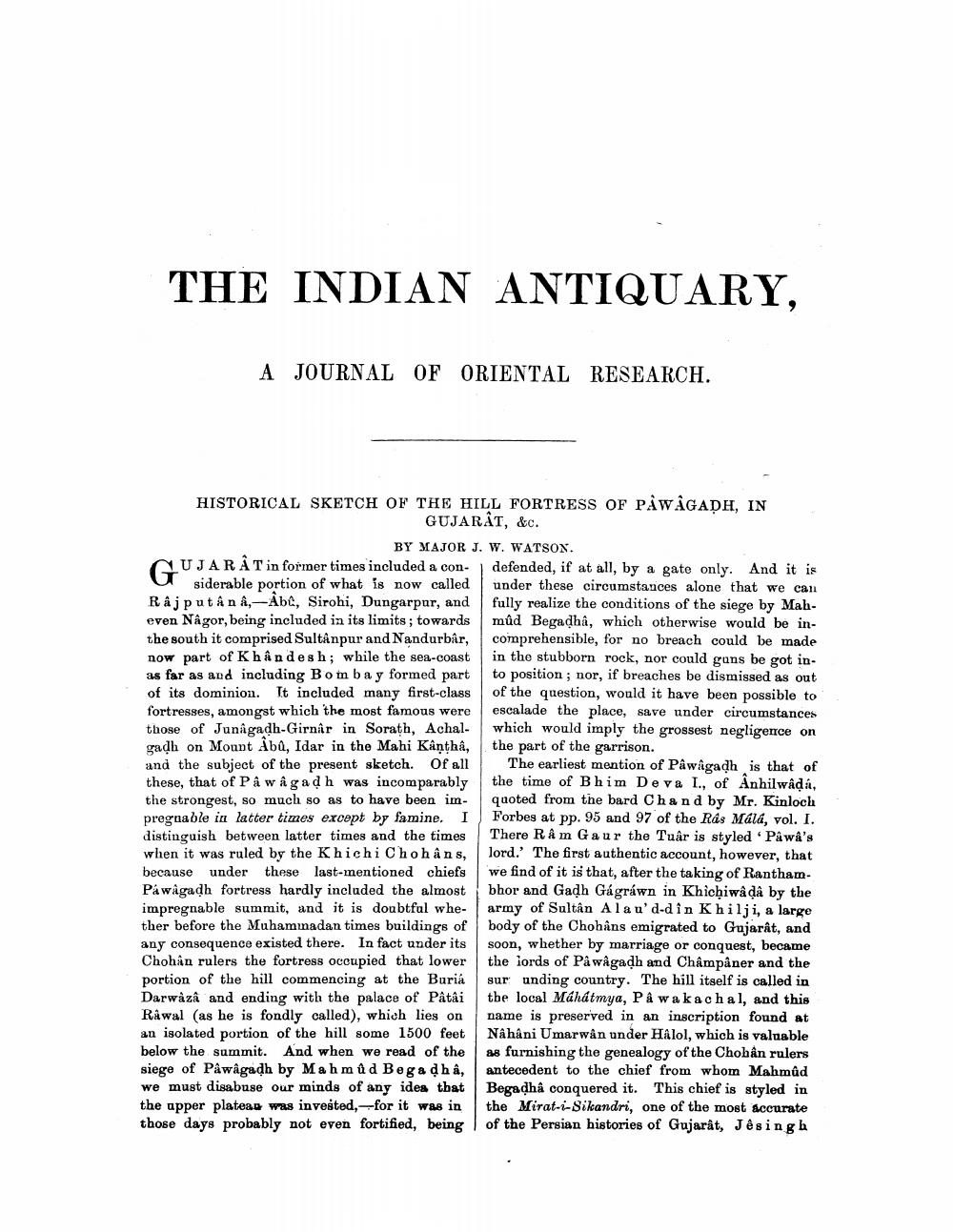Book Title: Indian Antiquary Vol 06 Author(s): Jas Burgess Publisher: Swati Publications View full book textPage 5
________________ THE INDIAN ANTIQUARY, A JOURNAL OF ORIENTAL RESEARCH. HISTORICAL SKETCH OF THE HILL FORTRESS OF PAWAGAḍH, IN GUJARAT, &c. BY MAJOR J. W. WATSON. G UJARAT in former times included a considerable portion of what is now called Rajputânâ,-Abê, Sirohi, Dungarpur, and even Någor, being included in its limits; towards the south it comprised Sultanpur and Nandurbâr, now part of Khandesh; while the sea-coast as far as and including Bom ba y formed part of its dominion. It included many first-class fortresses, amongst which the most famous were those of Junagadh-Girnâr in Sorath, Achalgadh on Mount Abû, Idar in the Mahi Kanthâ, and the subject of the present sketch. Of all these, that of Pawagadh was incomparably the strongest, so much so as to have been impregnable in latter times except by famine. I distinguish between latter times and the times when it was ruled by the Khichi Chohans, because under these last-mentioned chiefs Pawagadh fortress hardly included the almost impregnable summit, and it is doubtful whether before the Muhammadan times buildings of any consequence existed there. In fact under its Chohan rulers the fortress occupied that lower portion of the hill commencing at the Buria Darwaza and ending with the palace of Pâtâi Rawal (as he is fondly called), which lies on an isolated portion of the hill some 1500 feet below the summit. And when we read of the siege of Pawagadh by Mahmûd Begaḍhâ, we must disabuse our minds of any idea that the upper plateau was invested, for it was in those days probably not even fortified, being defended, if at all, by a gate only. And it is under these circumstances alone that we can fully realize the conditions of the siege by Mahmûd Begaḍhâ, which otherwise would be incomprehensible, for no breach could be made in the stubborn rock, nor could guns be got into position; nor, if breaches be dismissed as out of the question, would it have been possible to escalade the place, save under circumstances which would imply the grossest negligence on the part of the garrison. The earliest mention of Pâwagadh is that of the time of Bhim Deva I., of Anhilwâḍá, quoted from the bard Chand by Mr. Kinloch Forbes at pp. 95 and 97 of the Rás Málá, vol. I. There R&m Gaur the Tuâr is styled Pâwâ's lord.' The first authentic account, however, that we find of it is that, after the taking of Ranthambhor and Gadh Gágráwn in Khichiwâdâ by the army of Sultan Alau' d-din Khilji, a large body of the Chohâns emigrated to Gujarât, and soon, whether by marriage or conquest, became the lords of Pâwagadh and Châmpâner and the sur unding country. The hill itself is called in the local Mahatmya, Pâ wakachal, and this name is preserved in an inscription found at Nâhâni Umarwån under Hâlol, which is valuable as furnishing the genealogy of the Chohân rulers antecedent to the chief from whom Mahmûd Begadhâ conquered it. This chief is styled in the Mirat-i-Sikandri, one of the most accurate of the Persian histories of Gujarât, JêsinghPage Navigation
1 ... 3 4 5 6 7 8 9 10 11 12 13 14 15 16 17 18 19 20 21 22 23 24 25 26 27 28 29 30 31 32 33 34 35 36 37 38 39 40 41 42 43 44 45 46 47 48 49 50 51 52 ... 458
